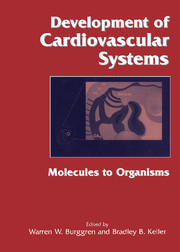Book contents
- Frontmatter
- Contents
- List of contributors
- Foreword by Constance Weinstein
- Introduction: Why study cardiovascular development?
- Part I Molecular, cellular, and integrative mechanisms determining cardiovascular development
- 1 Genetic dissection of heart development
- 2 Cardiac membrane structure and function
- 3 Development of the myocardial contractile system
- 4 Vasculogenesis and angiogenesis in the developing heart
- 5 Extracellular matrix maturation and heart formation
- 6 Endothelial cell development and its role in pathogenesis
- 7 Embryonic cardiovascular function, coupling, and maturation: A species view
- 8 Hormonal systems regulating the developing cardiovascular system
- Part II Species diversity in cardiovascular development
- Part III Environment and disease in cardiovascular development
- Epilogue: Future directions in developmental cardiovascular sciences
- References
- Systematic index
- Subject index
4 - Vasculogenesis and angiogenesis in the developing heart
from Part I - Molecular, cellular, and integrative mechanisms determining cardiovascular development
Published online by Cambridge University Press: 10 May 2010
- Frontmatter
- Contents
- List of contributors
- Foreword by Constance Weinstein
- Introduction: Why study cardiovascular development?
- Part I Molecular, cellular, and integrative mechanisms determining cardiovascular development
- 1 Genetic dissection of heart development
- 2 Cardiac membrane structure and function
- 3 Development of the myocardial contractile system
- 4 Vasculogenesis and angiogenesis in the developing heart
- 5 Extracellular matrix maturation and heart formation
- 6 Endothelial cell development and its role in pathogenesis
- 7 Embryonic cardiovascular function, coupling, and maturation: A species view
- 8 Hormonal systems regulating the developing cardiovascular system
- Part II Species diversity in cardiovascular development
- Part III Environment and disease in cardiovascular development
- Epilogue: Future directions in developmental cardiovascular sciences
- References
- Systematic index
- Subject index
Summary
The coronary vasculature begins to develop during primary cardiac morphogenesis, as the ventricular chamber walls thicken. Endothelial precursor cells reach the heart via the epicardium, where they form vascular tubes, a process termed “vasculogenesis.” These tubes coalesce to form a microvascular network that expands by sprouting (i.e., vessels are formed from preexisting vessels), a process termed “angiogenesis.” Subsequently, larger vessels are formed via unification of microvessels, and several of these vessels form a ring at the root of the aorta, coalesce, and then grow into the aorta, forming the two main coronary arteries. These events occur during a relatively short portion of the gestation period. Despite the importance of this aspect of heart development, our understanding of coronary vasculogenesis and angiogenesis has lagged behind our knowledge of other aspects of heart development. This chapter reviews the current status of this topic by considering precoronary, as well as coronary, events, and it explores the putative regulators of coronary vascular growth.
Precoronary events
Formation of the heart tubes occurs as endothelial cells migrate from the cardiogenic plate to the basal surface of the endoderm (Viragh et al., 1990). These endocardial angioblasts have been shown to arise from mesodermal tissue that lies just anterior to Hensen's node (Coffin & Poole, 1991). DeRuiter and colleagues (1993) postulated that endocardial endothelial cells originate from precursors that are independent of the cardiogenic plate. Recent data from Markwald (1995) on early expression of genes in cardiovascular development support this hypothesis. Subsequently, myocytes proliferate to form a myocardium, the cardiac jelly diminishes, and the endocardial surface becomes progressively more trabeculated.
- Type
- Chapter
- Information
- Development of Cardiovascular SystemsMolecules to Organisms, pp. 35 - 42Publisher: Cambridge University PressPrint publication year: 1998



